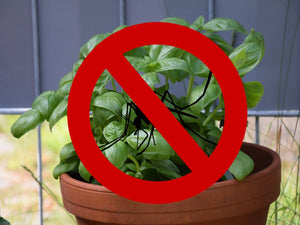12 Important Guidelines for Preventing and Controlling Plant Disease
DiseasesNothing is more frustrating than watching your once-thriving garden struggle with wilting leaves, discolored fruit, or stunted growth. Plant diseases can spread quickly, wiping out entire crops if left unchecked. But the good news is that most garden diseases can be prevented with the right strategies!

“An ounce of prevention is worth a pound of cure.” This saying especially applies to plant disease control. Many common diseases can be prevented by being proactive about how you manage your garden.
Disease occurs when susceptible plants are introduced to a pathogen and the environmental conditions are just right. Some garden diseases target certain plant families, while others are less discriminating and will wipe out most of your garden.

12 Important Guidelines for Plant Disease Prevention
1 - Follow Planting Guidelines
Plant when the soil is at the right temperature. If you’re not sure, consult your seed packets. The right environment for seed germination will allow the plants to grow and establish quickly and prevent seed decay and damping off.
2 - Rotate Your Crops
To prevent pathogen buildup, rotate the types of plants you grow from year to year. An ideal crop rotation is every 3-5 years, so consider planning a progression for the various areas in your garden.
3 - Plant Healthy Seeds and Transplants
Inspect seeds and transplants before they go into the garden. Only save seeds of healthy plants for growing in future seasons, and choose disease-resistant varieties when possible.
4 - Encourage Strong Plant Growth
Healthy plants are naturally more resistant to disease. Provide proper nutrients, water, and sunlight to promote vigorous growth.
5 - Use Organic Soil Amendments
Adding organic matter such as compost to the soil as needed will help the soil retain water and nutrients, as well as encourage a healthy soil with beneficial microorganisms to help you keep your plants in great shape.
6 - Use Proper Spacing and Trellising
Overcrowded plants create humid conditions that encourage fungal diseases. Space plants appropriately and use trellises to improve air circulation and keep leaves off the ground.
7 - Water Wisely and Ensure Good Drainage
Overwatering and soggy soil can lead to damping off in seedlings and various forms of root, crown, and stem rot in established plants. Choose well-draining soil for your crops, or consider raised beds if you don’t have any suitable land. Water in the morning at the base of the plants, and don't overwater.
8 - Keep Weeds Under Control
Weeds can harbor diseases and pests. Regularly remove weeds to reduce disease risks and competition for nutrients.
9 - Manage Insect Control
Many insects, such as aphids and beetles, spread plant diseases. Monitor your garden for pests and use natural or organic pest control methods to keep their populations in check.
10 - Mulch to Protect Plants and Soil
Mulching helps retain moisture, suppress weeds, and prevent soil-borne diseases from splashing onto plant leaves. Use organic mulch such as straw, wood chips, or compost.
11 - Maintain Garden Sanitation
Remove diseased plants and residue after your last harvest rather than leaving them in the soil. Trim and remove any diseased plants or leaves immediately.
12 - Use Preventative Treatments
Organic treatments such as copper and sulfur-based sprays, Bacillus subtilis (Bt), neem oil, and bicarbonates can help prevent diseases. However, these treatments do not cure established infections.
In short, keep an eye on your garden! Check your plants often to monitor the general health of your plants so that you can act quickly if you do see signs of disease.
Garden diseases can be frustrating to deal with, and after a plant is sick, it may never fully recover. If your garden does get infected with disease, you may need to take some steps to remediate the soil. It’s important to keep ahead of the game and do everything you can to set yourself up for success ahead of time.
You can have a healthy, thriving garden by paying attention and practicing good gardening habits.

5 Types of Garden Diseases
Plant diseases typically fall into five categories: bacteria, viruses, fungi, water molds, and nematodes.
Bacterial diseases tend to develop on older leaves first, whereas viral diseases will develop on younger leaves.
Fungal diseases develop in moderate temperatures when plants stay wet for many hours a day. These diseases include blight, fusarium and verticillium wilts, powdery mildew, various rusts, anthracnose, and leaf spots.

Symptoms Your Plants May Be Sick
If your plant isn’t flourishing, look for symptoms in order to diagnose the problem. Plants can fail to thrive due to a lack of nurture, pests, or even soil deficiency. If you think you might have a plant disease on your hand, inspect your plants carefully. Consulting pictures of various diseases may also be helpful.
Common Signs of Plant Disease
- Wilted or stunted leaves
- Rapid death of leaves
- Discoloration on leaves or fruit
- Decay on fruit or stems

Getting a handle on understanding plant diseases can save you from devastating losses in your garden. They are responsible for the death of many plants and can spread quickly if not controlled. Regular monitoring is key.
By following these 12 essential guidelines for disease prevention, you can protect your plants, boost their natural defenses, and keep your garden healthy and productive all season long.
Written by Teresa Chandler
More Resources:
Disease Management in the Home Vegetable Garden - University of Massachusetts Amherst
Common Diseases in the Home Garden - University of Missouri Extension
Disease Control - University of Illinois Extension
Disease Management in the Home Vegetable Garden - University of Georgia Extension
Managing Garden Diseases - West Virginia University Extension
Disease Control - Texas A&M AgriLife Extension Service






Leave a comment